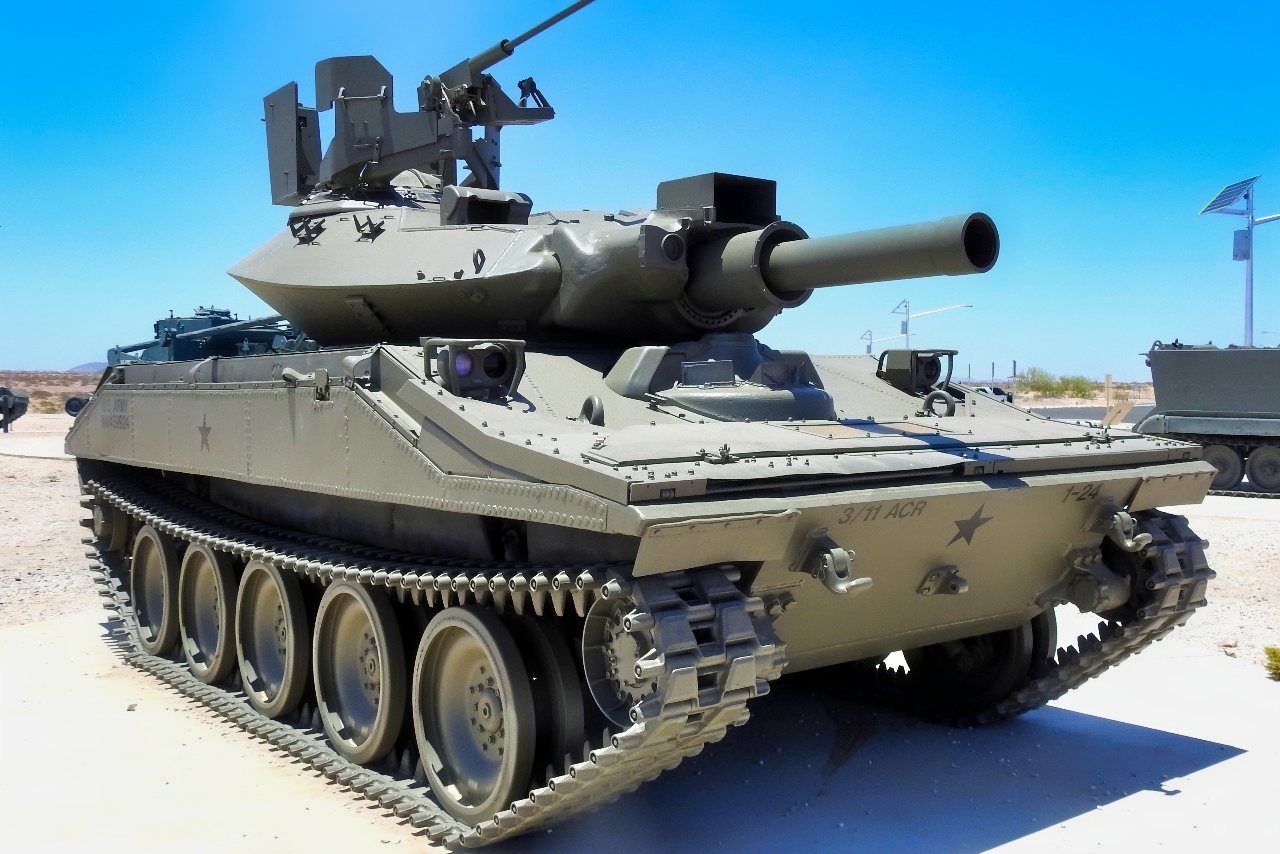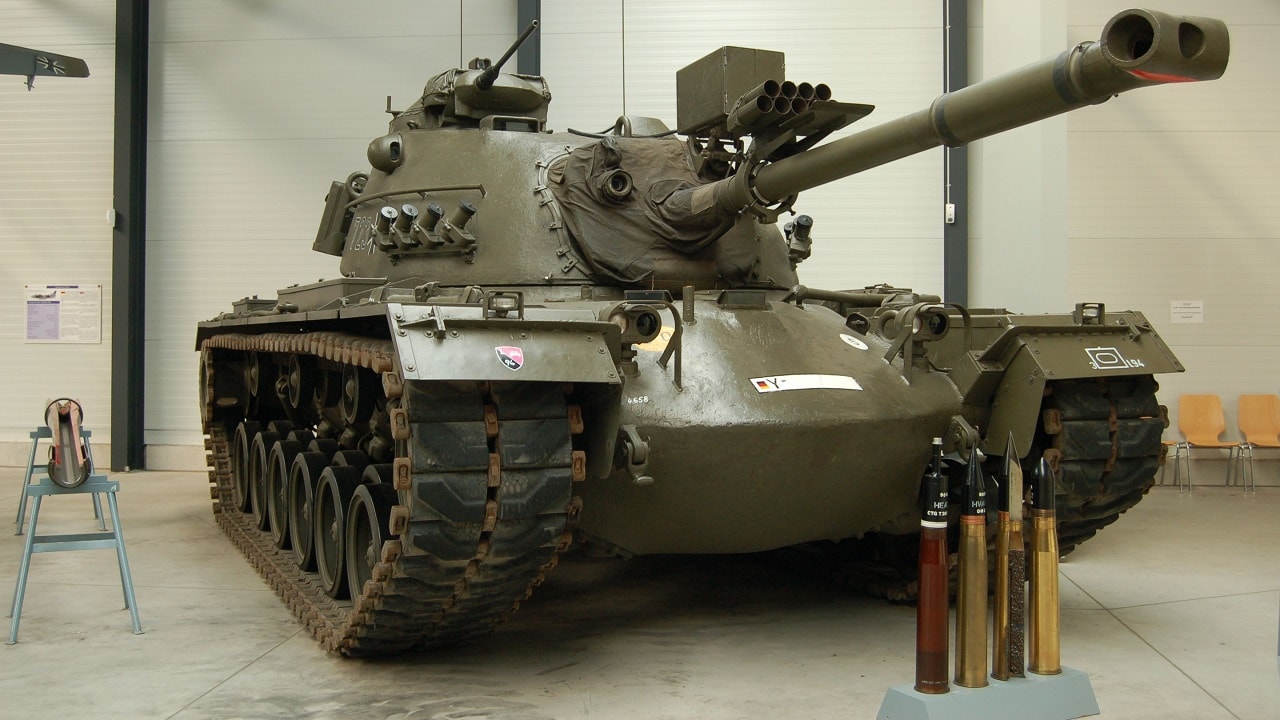Key Points and Summary – The M551 Sheridan was a unique air-droppable light tank developed to provide armored firepower for the 82nd Airborne Division.
-Its best features were its light weight, amphibious capability, high speed, and a powerful 152mm gun/launcher that could fire both conventional rounds and the Shillelagh anti-tank missile.

M551 Sheridan Light Tank. Image Credit: Creative Commons.
-However, the Sheridan was plagued by serious drawbacks, including dangerously thin aluminum armor that made it vulnerable to mines and RPGs, and a combustible ammunition design that was hazardous to the crew.
-Despite a checkered reputation in Vietnam, it served effectively in Panama and Desert Storm before its retirement in 1996.
The Best Features of the M551 Sheridan Light Tank
The M551 Sheridan was called an AR/AAV, or Armored Reconnaissance/Airborne Assault Vehicle. But it was actually an Army light tank. It was amphibious and could swim rivers at 3-4 mph.
The most interesting thing about the Sheridan was that it could be dropped by parachute, which gave it a much longer service life as the only organic armored vehicle in the 82nd Airborne Division.
The Sheridan was named after General Phillip Sheridan, the Union’s outstanding cavalry commander during the Civil War. Sheridan was best known for his rise from 1st Lieutenant to Major General during the Civil War, and his Shenandoah Campaign in 1864 to destroy the “breadbasket” of the Confederacy.
The Birth Of The Sheridan
The Army in the late 1950s faced the same problem with its Airborne divisions that it had in World War II. The divisions could rapidly deploy anywhere in the world with little to no notice, but once they hit the ground, they lacked organic, armored vehicles to eliminate enemy armor or strongpoints.
The Army wanted a lightweight, air-deliverable vehicle capable of carrying a real cannon, providing some protection, and offering enough mobility to run with airborne units and race to where the fighting was the heaviest for the light infantry paratroopers.

M551 Sheridan U.S. Army. Image Credit: Creative Commons.
Originally designed as an armored reconnaissance vehicle for cavalry units, it saw extensive action in Vietnam and has a checkered history there. After the war in Vietnam ended, the Army retained the Sheridan in the 82nd Airborne Division, where the airdropable light tank fulfilled a need.
It was lightweight, could be airdropped or airlanded, raced to the battle with the infantry, and provided heavier firepower for the troopers.
The Sheridan, while not the best solution for the 82nd Airborne’s needs for armor, has still never been replaced.
So, what were the best features of the Sheridan, the Army’s airborne tank?
The Best Features of the M551 Sheridan
The best features of the M551 Sheridan were its lightweight, air-transportable design and its 152mm gun/launcher, which could fire both conventional rounds and the MGM-51 Shillelagh anti-tank missile.
These features made it a mobile and highly capable reconnaissance vehicle with the potential for heavy firepower, though it also had limitations due to its lightweight aluminum armor.
The Sheridan was more mobile than the M48 Patton tanks, better armored than the M113 armored personnel carriers it was replacing, and had good cross-country mobility and speed.

M48 Patton. Image Credit: Creative Commons.
The Sheridan was powered by a large 300-hp (224 kW) Detroit Diesel 6V53T diesel engine and a flat track (no support rollers). The XM551 thus had an excellent power-to-weight ratio and mobility, able to run at speeds up to 72 km/h (45 mph).
The flotation screen could be deployed to ford rivers with the infantry. It was well-suited for its reconnaissance role due to its low profile and speed.
The Sheridan, for such a small vehicle, carried a lot of firepower. Its M81E1 Rifled 152-mm main gun carried 20 rounds and eight to nine MGM-51 Shillelagh missiles. This armament could defeat any known armor and destroy bunkers and built-up positions.
The weapon also fired M625 canister rounds loaded with thousands of flechettes, also known as “beehive rounds,” which decimated light Viet Cong infantry during the battles of Tay Ninh and Bien Hoa.
The M551 also carried a .50 caliber heavy machine gun and a 7.62mm GPMG in the turret. The Sheridan had a low profile and had advanced night fighting capabilities (for the time frame).
Biggest Drawbacks of the Sheridan
Troops distrusted the Sheridan before it even had arrived in South Vietnam because of its lack of armor. The hull was made of aluminum and was very thin. The turret was made of steel, but it, too, didn’t have thick armor.
Therefore, the Sheridan was extremely vulnerable to anti-tank mines and rocket-propelled grenades, which were the favorite weapons of the Viet Cong and North Vietnamese regulars.
The vehicle also had a major issue with 152 mm ammunition. The round was attached to the propellant charge, which was combustible, and many times, the projectile separated from the combustible case during loading. Therefore, the tank’s crewmen were trained not to load the round.
Because the highly combustible propellant charge was held inside the turret, the crews were trained to abandon the vehicle at the first sign of fire or smoke inside the tank.
The Sheridan’s rate of fire could have been faster: only about two rounds per minute, while a well-trained M48 crew could fire 18-19 rounds per minute. Another issue was that the tank was light (15 tons). When the main gun was fired, the front of the tank rocked upward, and the hatch ring often injured the commander in the open hatch as it rocked backward.
The Sheridan Goes To Two More Wars
The Army began phasing out the Sheridan in 1978, but the 82nd Airborne had a use for them as deployable armor for the division. In 1988, when the 82nd deployed to Honduras during “Operation Golden Pheasant,” Sheridans were deployed but airlanded during the brief Nicaraguan “invasion.”
In 1989, however, the Sheridan earned its combat jump wings. During the invasion of Panama, the 82nd jumped at Tocumen airport. That’s where 10 Sheridans were airdropped via C-141 Starlifter aircraft. These were part of C Co. 3/73 Armor. Four others were secretly brought in before the invasion via C-5 Galaxy aircraft at Howard Air Force Base.
The Sheridans received high marks in Panama because the Panamanian military primarily had small arms and generally lacked the stomach for fighting against armor.
The Sheridan was deployed in Operation Desert Shield/Desert Storm in 1990-91. Due to its thin armor, it saw action but was limited to a flanking reconnaissance role. There, it fired the Shillelagh missiles for the first and only time in combat. Once again, Sheridan tanks received high marks.
Retirement
The Sheridan was finally retired from the 82nd Airborne in 1996. Some of the Sheridans found a home in the National Training Center, where they are used as OPFOR (opposing force) tanks.
No replacement has yet been adopted for the Sheridan, and the light airborne division could use one. But for now, the paratroopers are using Javelin missiles for anti-tank defense.
About the Author: Steve Balestrieri
Steve Balestrieri is a National Security Columnist. He served as a US Army Special Forces NCO and Warrant Officer. In addition to writing on defense, he covers the NFL for PatsFans.com and is a member of the Pro Football Writers of America (PFWA). His work was regularly featured in many military publications.
More Military
The F-22 Raptor Stealth Fighter Still Haunts the U.S. Air Force
The U.S. Navy’s Big Nuclear Attack Submarine Mistake Still Stings
China’s J-20 Mighty Dragon vs. F-22 Raptor Stealth Fighter Summed Up in 4 Words
Why Is a U.S. Navy Aircraft Carrier Still Damaged 8 Months After a Collision?










